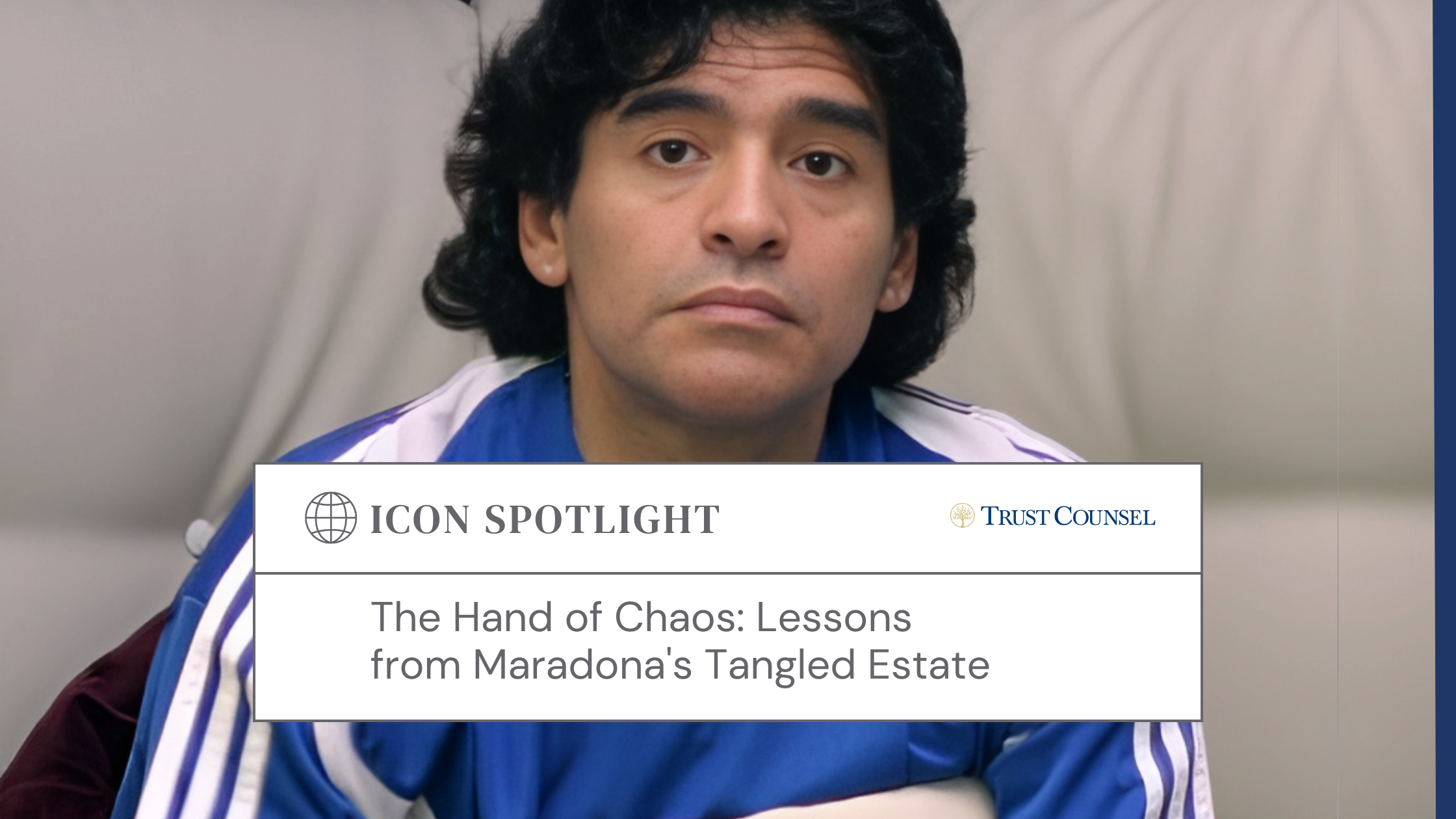As the host of the wildly popular The Joy of Painting TV series on PBS, Bob Ross became a pop-culture icon, who was equally famous for his giant head of hair, soothing baritone voice, and folksy demeanor as he was for his iconic landscape paintings. And like so many other artists, Bob’s artwork and image would become even more popular following Bob’s death in 1995.
Bob’s philosophy in both painting and life was that there “were no mistakes in life… just happy little accidents.” Sadly, as detailed in the recent Netflix documentary Bob Ross: Happy Accidents, Betrayal & Greed, Bob’s failure to coordinate his business agreements with his estate plan was anything but happy, leaving his only son largely unable to benefit from his father’s fame and fortune.
As we’ll discuss in this series, Bob’s planning failures have led to an ugly court battle between his former business partners and his family, who were fighting for control of the lucrative intellectual property rights to the Bob Ross brand. And while Bob’s son Steve ultimately lost his fight to benefit from the business empire built on his father’s persona and painting skills, we’ll explain the steps you can take to ensure that your loved ones don’t suffer the same fate and are able to fully benefit from all of your business assets following your death.
Building Bob Ross
After meeting Bob at one of his early in-person painting classes, husband and wife duo Walter and Annette Kowalski convinced Bob to go into business with them, launching Bob Ross Inc. (BRI) in 1985. According to the Daily Beast, the corporation, which was formed in Virginia, initially consisted of four equal partners: Bob Ross and his wife Jane Ross, along with Walter and Annette.
With the Kowalski’s financial backing, BRI’s initial business model had Bob teaching a series of in-person painting classes up and down the U.S. east coast at which they sold painting supplies and art instruction manuals. But after signing on with PBS for The Joy of Painting series and launching their own line of Bob Ross-brand painting and art supplies, business began to take off.
From 1986 through 1994, BRI registered several trademarks using Bob Ross’ name and likeness, and the company also signed several licensing agreements with third parties, all with Bob’s consent. All four individuals—Bob, Jane, Walter, and Annette—were technically equal partners in the corporation, but it was widely acknowledged that Bob was the one in charge, as well as the one with the talent and the face of the brand.
In fact, when The Joy of Painting became one of PBS’s top-ranked shows at the close of the 1980s, the frizzy-headed artist grew into a bona-fide celebrity. Bob made appearances on popular talk shows of the day like Regis and Kathy Lee and Donahue, and Bob was also a featured star at the Grand Ole Opry in Nashville. At the peak of his fame, Bob even had plans to launch his own musical based on his TV show.
The success of the show and Bob’s fame boosted sales of Bob Ross art supplies, which branched out to include books and videos in addition to the paints and brushes adorned with Bob’s name and likeness. BRI eventually started offering painting workshops around the U.S., with teachers trained in Bob’s method doing the instruction.
All of this translated to significant financial success for the company. Based on records made public during the lawsuits over Bob’s estate, BRI was bringing in roughly a half-million dollars each year for the four partners to share, according to the Daily Beast. But the good times wouldn’t last.
Things Fall Apart
Things started to go downhill in 1992 when Bob’s wife Jane passed away from cancer. Following her death, the structure of BRI required that Jane’s share in the company be divided equally among the surviving three partners. As a result, Bob was reduced to owning just one-third of the company that bore his name and likeness. This was likely not understood by the Ross’s when they signed their partnership agreements.
Shortly after Jane’s death, Bob developed lymphoma. In 1994, while battling cancer, the Kowalskis offered Bob a deal. They reportedly faxed him an agreement that would give them all of Bob’s intellectual property rights as well as all of his artistic works. In return, the Kowalskis would pay Ross or his surviving heirs 10% of BRI’s profits, but only for the next 10 years. After 10 years was up, the Kowalskis would own all income from Bob Ross, Inc—forever.
Not surprisingly, Bob refused to sign the agreement, and he was reportedly infuriated that the Kowalskis would even ask him to sign such a one-sided deal. In an attempt to protect his rights to his business and intellectual property assets, Bob made several last-minute changes to his estate plan. The most notable change was made to Bob’s trust just two months before his death.
In the amendment to the Bob Ross Trust, Bob added a clause that specified
that all intellectual property rights to Bob’s “name, likeness, voice, and visual, written, or otherwise recorded work” would pass to his son, Steve, and Bob’s half-brother, Jimmie Cox. Specifically, Bob assigned 51% of the interest to all of his intellectual property to Jimmie and 49% to Steve.
Oddly, though Bob’s estate plan specifically left his intellectual property to Steve and Jimmie, Jimmie apparently never shared this fact with Steve, who would only learn of the changes to his father’s estate plan some two decades later.
Grand Theft Bob
Bob Ross died on July 4, 1995, at age 52. Upon his death, his estate was valued at $1.3 million, half of which was his one-third share in BRI. Unable to gain full control over Bob’s share of BRI while Bob was alive, the Kowalski’s decided to sue Bob’s estate after his death. In addition to seeking all of his intellectual property rights in their lawsuit, the Kowalski’s also wanted all of Bob’s finished paintings—and even all of Bob’s art tools and paints down to his easel and brushes.
The Kowalski’s lawsuit was so expansive and their legal tactics so brutal that one of Bob’s old friends took to calling their efforts “Grand Theft Bob.” In the end, Kowalski’s legal strategy was designed to gain complete control of Bob’s afterlife, despite Bob’s clear wishes to the contrary.
Without the financial means to sustain a prolonged legal battle, the estate’s executor, Jimmie Cox, settled with the Kowalskis in 1997. The settlement agreement was accompanied by an assignment of all of Bob’s intellectual property rights, which stated that “To the extent, if any, any such rights or incidents of ownership are somehow vested in Estate, Estate hereby conveys, transfers and assigns all such rights and incidents of ownership and ownership itself to BRI.”
Additionally, both the estate and the Bob Ross Trust also signed separate mutual releases with BRI which state that the parties and their heirs, assigns, successors in interest, etc., “do, now and forever, absolutely and irrevocably, hereby release each other in and from any and all claims, suits, liabilities, complaints, losses, damages, and charges of every kind and character arising prior to the date of execution hereof.”
Bob Ross Reboot
As with so many other artists, Bob Ross’s fame reached its zenith in the years following his death. Although The Joy of Painting’s last episode aired in 1995, as the years went by, more and more people would discover the iconic artist’s work and persona via the Internet. And when Annette and Walt Kowalski handed control of BRI to their daughter Joan in 2012, the Bob Ross brand would reach dizzying new heights.
Things really began to take off in 2015, when Joan was approached by the licensing company Janson Media, which wanted to add The Joy of Painting to a new online streaming platform called Twitch. With 403 episodes to pull from, Twitch launched a Bob Ross marathon, and the Bob Ross brand soon reached millions of new fans.
Joan discussed the Bob Ross reboot with the online journal Vocativ in 2015: “Twitch. TV woke up the world,” said Joan. “They made everybody remember their childhood again even though we’ve always been here… We are freakin’ out.”
Following the Twitch broadcast, Joan was approached by another brand-management firm known as Firefly, and that’s when the money really started pouring in. Today, you can find everything from Bob Ross bobbleheads and Bob Ross chia pets to Bob Ross Christmas ornaments and even action figures. Both Netflix and Twitch stream The Joy Of Painting series, and there’s a Bob Ross sleep app available through the Calm meditation app platform.
All of these licensing opportunities translated to major money for BRI. According to the Daily Beast, in 2012, when Joan took over, BRI brought less than $200 in licensing revenue outside of its paint products. But by 2016, that figure had grown to $460,000, and by 2017, Bob Ross-branded products were bringing more than a million dollars in licensing fees to BRI each year.
Steve Sues BRI
Although shortly before his death, Bob amended his estate plan to transfer all of his intellectual property rights to his son, Steve, and half-brother, Jimmie Cox, Steve claimed that he never knew his father made such a move. In fact, it would be more than 20 years after his father’s death before Steve claims he found out about the clause in his father’s trust.
Based on this knowledge, Steve sued BRI, alleging that all of the licensing deals and products that used his father’s name and likeness were unauthorized. In his lawsuit, Steve demanded compensation for the years of unauthorized use of the intellectual property rights Steve claims to own based on his father’s estate plan.
Sadly for Steve, the court didn’t agree with his claim. In 2019, the court ruled that Bob Ross’s trust could not have assigned the intellectual property rights to Steve and Jimmie because the Trust did not own those rights to begin with. Specifically, the court stated in its ruling, “Plaintiff would not own the intellectual property at issue because the Trust never owned it. Similarly, because Bob Ross gave BRI his right to publicity during his lifetime, it could not have transferred to his son on his death.”
In other words, it didn’t matter that the Bob Ross Trust left Steve his father’s intellectual property rights because the Trust never owned those rights. Instead, the court found
Bob had transferred all of his intellectual property to BRI during his lifetime via oral contracts. Therefore, the amendment to Bob’s trust was irrelevant, since Bob Ross had already given all of the rights to his intellectual property to BRI.
Although Steve thought he could win an appeal of his case, he didn’t have the money to continue to fight BRI, so he ended up settling with the Kowalski family. In exchange for a modest payment, Steve gave up his claims to his father’s intellectual property. However, in the settlement, Steve did win the right to move forward with a business using his own name.
Since then, Steve has launched his own business teaching painting workshops in the very same studio where his father began his career more than 25 years earlier. Steve was joined in his new venture by his father’s old friend Dana Jester, and they held their first workshop together in September 2019, when several dozen artists gathered to learn from the two most talented masters of the Bob Ross painting technique still alive today.
In the end, although Bob Ross clearly intended to leave his intellectual property rights to his son, because Bob failed to coordinate his business agreements with his estate plan, his son Steve will never share in the fortune that has been made by the vast business empire built on his father’s name, likeness, and persona.
Learn From Bob’s Mistakes
Fortunately, you can easily prevent your loved ones from suffering the same fate as Steve using proper estate planning. Next week in part two of this series, we’ll discuss how you can use estate planning to ensure that all of your business assets, including any intellectual property you own, are protected and passed on to your family following your death or incapacity.
Until then, if you have a business, intellectual property, or any other type of asset that you want to include in your estate plan, meet with us as your Personal Family Lawyer®. With our support and guidance, we can ensure that your loved ones will always be provided for and stay out of court and out of conflict no matter what happens to you.
This article is a service of Trust Counsel, Personal Family Lawyer®. We don’t just draft documents; we ensure you make informed and empowered decisions about life and death, for yourself and the people you love. That’s why we offer a Family Wealth Planning Session,™ during which you will get more financially organized than you’ve ever been before, and make all the best choices for the people you love. You can begin by calling our office today to schedule a Family Wealth Planning Session.




